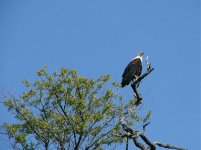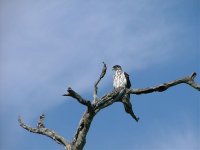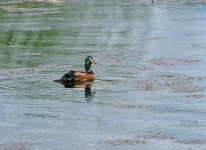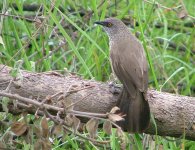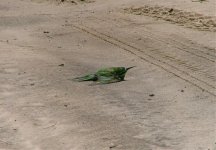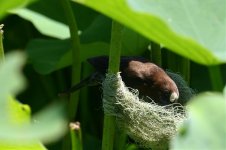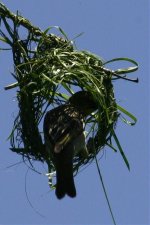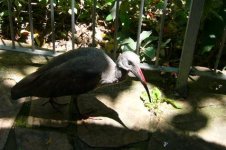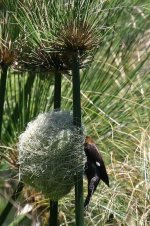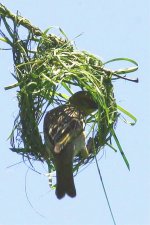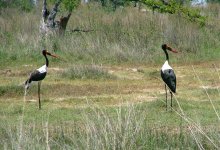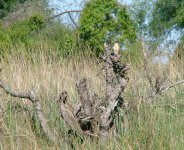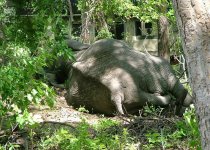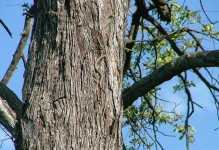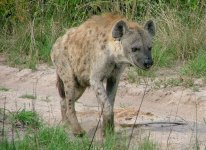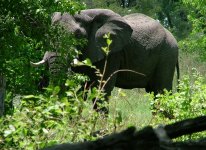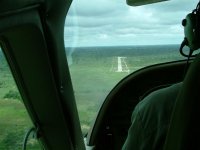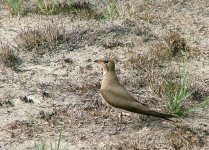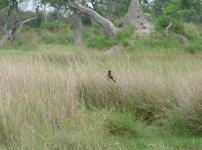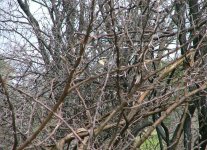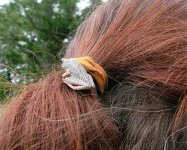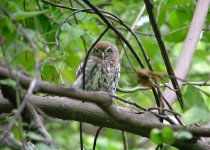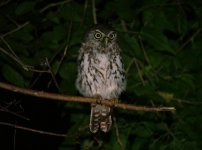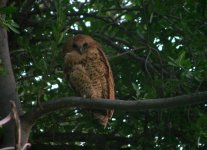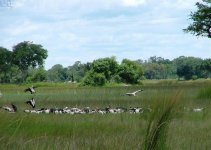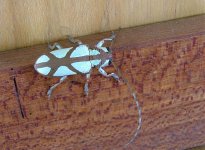Dave Kennedy
Well-known member
Second Big Birding Day - Nxabega
Nxabega is a concession in the heart of the Delta, a little way west of Chief's Island. I had received an invitation from Nxabega to join their guides for BBD, and needless to say I was delighted to accept.
The potential for encounters with dangerous game meant that most of our birding would be done from a game-viewing vehicle, but, since there was only myself and a squad of experienced safari guides, we managed to sneak in a couple of good walks in the bush.
Since the secret of scoring on BBD is to be where the birds are, we decided that, at first light, when birds are most active, we would start with three of the most productive habitats on the concession. These were a) in the vicinity of the Lodge itself b) mixed woodland and c) the spectacular riparian forest that fringes Delta islands. From there we would move out into savannah, floodplain grasslands, wetlands and permanent swamp with a couple of diversions into open-water lagoons and smallish islands. In this way we hoped to cover most of the habitats on the property.
There were some surprising omissions- only one dove, and only one bustard/korhaan, which are usually easy at Nxabega. African Scops-owl, normally fairly common, led us a dance - eventually we went and sat in the middle of the airstrip under the stars, switched the engine off, and listened. And there it was, that soft "prruup", borne on the cool night air from a forest patch close to the lodge. We had an exciting moment on our night-hunt for owls when we came across a beautiful female leopard.
The little blue-cheeked bee-eater gave us a bad moment (see photo). When we came upon him sprawled on the sandy track we thought we had come upon a tragic traffic accident. It was only when we drove right up to him that he condescended to get to his feet and fly up into the tree above and start preening. He had been enjoying a sunbathe. The pygmy goose (photo) is noteworthy in that I have failed to get close to them for years. All you usually see is their white wing flashes as they fly away from you at top speed. This one is the first laid-back pygmy goose I have ever met.
Our efforts yielded 160 species. Not a bad effort.
Best wishes,
Dave Kennedy
Species observed
Apalis, Yellow-breasted
Babbler, Arrow-marked
Babbler, Hartlaub's
Barbet, Black-collared
Barbet, Crested
Bateleur
Batis, Chinspot
Bee-eater, Blue-cheeked
Bee-eater, European
Bee-eater, Little
Bee-eater, Swallow-tailed
Bee-eater, White-fronted
Boubou, Swamp
Brubru
Buffalo-weaver, Red-billed
Bulbul, Dark-capped
Bush-shrike, Orange-breasted
Bustard, Black-bellied
Camaroptera, Grey-backed
Cisticola, Chirping
Cisticola, Rattling
Cisticola, Zitting
Cormorant, Reed
Coucal, Coppery-tailed
Coucal, Senegal
Coucal. White-browed
Crake, African
Crake, Black
Crane, Wattled
Crombec, Long-billed
Cuckoo, African
Cuckoo, Levaillant's
Darter, African
Dove, Red-eyed
Drongo, Fork-tailed
Duck, Comb
Duck, White-faced
Duck, Yellow-billed
Eagle, Wahlberg's
Eagle-owl, Verreaux's
Egret. Cattle
Egret, Great
Egret, Little
Egret, Slaty
Egret, Yellow-billed
Firefinch, Brown
Firefinch, Jameson's
Firefinch, Red-billed
Fish-eagle, African
Flycatcher, African Dusky
Flycatcher, Spotted
Francolin, Crested
Go-away Bird, Grey
Goose, Egyptian
Goose, Spurwinged
Greenbul, Yellow-bellied
Green-pigeon, African
Greenshank, Common
Ground-hornbill, Southern
Guineafowl, Helmeted
Hamerkop
Hawk-eagle, African
Heron, Black
Heron, Goliath
Heron, Green-backed
Heron, Grey
Heron, Purple
Heron, Rufous-bellied
Heron, Squacco
Honeyguide, Greater
Hoopoe, African
Hornbill, African Grey
Hornbill, Red-billed
Hornbill, Southern Yellow-billed
Jacana, African
Kestrel, Dickinson's
Kingfisher, Grey-headed
Kingfisher, Malachite
Kingfisher, Pied
Kingfisher, Striped
Kingfisher, Woodland
Kite, Black-shouldered
Kite, Yellow-billed
Lapwing, Blacksmith
Lapwing, Crowned
Lapwing, Long-toed
Mousebird, Red-faced
Neddicky
Openbill, African
Oriole, Black-headed
Owl, Barn
Owlet, African Barred
Oxpecker, Red-billed
Oxpecker, Yellow-billed
Painted-snipe, Greater
Palm-swift, African
Paradise-flycatcher, African
Parrot, Meyer's
Pelican, Great White
Pipit, African
Pipit, Plain-backed
Plover, Three-banded
Pratincole, Collared
Prinia, Black-chested
Prinia, Tawny-flanked
Puffback, Black-backed
Pygmy-goose, African
Quail, Common
Quail, Harlequin
Robin-chat, White-browed
Roller, Broad-billed
Roller, Lilac-breasted
Roller, Rufous-crowned (Purple)
Ruff
Sandgrouse, Double-banded
Sandpiper. Marsh
Sandpiper, Wood
Scimitarbill, Common
Scops-owl, African
Scrub-robin, Kalahari
Scrub-robin, White-browed
Shrike, Crimson-breasted
Shrike, Lesser Grey
Shrike, Magpie
Shrike, Red-backed
Snake-eagle, Brown
Snipe, African
Sparrow. Southern Grey-headed
Spoonbill, African
Spur-fowl, Red-billed
Spur-fowl, Swainson's
Starling, Burchell's
Starling, Greater-blue-eared
Starling, Wattled
Stilt, Black-winged
Stork, Marabou
Stork, Saddle-billed
Stork, Yellow-billed
Sunbird, Scarlet-chested
Sunbird, White-bellied
Swallow, Barn
Swallow, Red-breasted
Tchagra, Black-crowned
Teal, Red-billed
Thick-knee, Water
Thrush, Groundscraper
Tinkerbird, Yellow-fronted
Tit, Southern Black
Turtle-dove, Cape
Vulture, Hooded
Vulture, White-backed
Waxbill, Blue
Waxbill, Common
Weaver, Golden
Weaver, Red-headed
Weaver, Southern Brown-thoated
Whydah, Pin-tailed
Wood-dove, Emerald-spotted
Wood-hoopoe, Green
Woodpecker, Golden-tailed
Nxabega is a concession in the heart of the Delta, a little way west of Chief's Island. I had received an invitation from Nxabega to join their guides for BBD, and needless to say I was delighted to accept.
The potential for encounters with dangerous game meant that most of our birding would be done from a game-viewing vehicle, but, since there was only myself and a squad of experienced safari guides, we managed to sneak in a couple of good walks in the bush.
Since the secret of scoring on BBD is to be where the birds are, we decided that, at first light, when birds are most active, we would start with three of the most productive habitats on the concession. These were a) in the vicinity of the Lodge itself b) mixed woodland and c) the spectacular riparian forest that fringes Delta islands. From there we would move out into savannah, floodplain grasslands, wetlands and permanent swamp with a couple of diversions into open-water lagoons and smallish islands. In this way we hoped to cover most of the habitats on the property.
There were some surprising omissions- only one dove, and only one bustard/korhaan, which are usually easy at Nxabega. African Scops-owl, normally fairly common, led us a dance - eventually we went and sat in the middle of the airstrip under the stars, switched the engine off, and listened. And there it was, that soft "prruup", borne on the cool night air from a forest patch close to the lodge. We had an exciting moment on our night-hunt for owls when we came across a beautiful female leopard.
The little blue-cheeked bee-eater gave us a bad moment (see photo). When we came upon him sprawled on the sandy track we thought we had come upon a tragic traffic accident. It was only when we drove right up to him that he condescended to get to his feet and fly up into the tree above and start preening. He had been enjoying a sunbathe. The pygmy goose (photo) is noteworthy in that I have failed to get close to them for years. All you usually see is their white wing flashes as they fly away from you at top speed. This one is the first laid-back pygmy goose I have ever met.
Our efforts yielded 160 species. Not a bad effort.
Best wishes,
Dave Kennedy
Species observed
Apalis, Yellow-breasted
Babbler, Arrow-marked
Babbler, Hartlaub's
Barbet, Black-collared
Barbet, Crested
Bateleur
Batis, Chinspot
Bee-eater, Blue-cheeked
Bee-eater, European
Bee-eater, Little
Bee-eater, Swallow-tailed
Bee-eater, White-fronted
Boubou, Swamp
Brubru
Buffalo-weaver, Red-billed
Bulbul, Dark-capped
Bush-shrike, Orange-breasted
Bustard, Black-bellied
Camaroptera, Grey-backed
Cisticola, Chirping
Cisticola, Rattling
Cisticola, Zitting
Cormorant, Reed
Coucal, Coppery-tailed
Coucal, Senegal
Coucal. White-browed
Crake, African
Crake, Black
Crane, Wattled
Crombec, Long-billed
Cuckoo, African
Cuckoo, Levaillant's
Darter, African
Dove, Red-eyed
Drongo, Fork-tailed
Duck, Comb
Duck, White-faced
Duck, Yellow-billed
Eagle, Wahlberg's
Eagle-owl, Verreaux's
Egret. Cattle
Egret, Great
Egret, Little
Egret, Slaty
Egret, Yellow-billed
Firefinch, Brown
Firefinch, Jameson's
Firefinch, Red-billed
Fish-eagle, African
Flycatcher, African Dusky
Flycatcher, Spotted
Francolin, Crested
Go-away Bird, Grey
Goose, Egyptian
Goose, Spurwinged
Greenbul, Yellow-bellied
Green-pigeon, African
Greenshank, Common
Ground-hornbill, Southern
Guineafowl, Helmeted
Hamerkop
Hawk-eagle, African
Heron, Black
Heron, Goliath
Heron, Green-backed
Heron, Grey
Heron, Purple
Heron, Rufous-bellied
Heron, Squacco
Honeyguide, Greater
Hoopoe, African
Hornbill, African Grey
Hornbill, Red-billed
Hornbill, Southern Yellow-billed
Jacana, African
Kestrel, Dickinson's
Kingfisher, Grey-headed
Kingfisher, Malachite
Kingfisher, Pied
Kingfisher, Striped
Kingfisher, Woodland
Kite, Black-shouldered
Kite, Yellow-billed
Lapwing, Blacksmith
Lapwing, Crowned
Lapwing, Long-toed
Mousebird, Red-faced
Neddicky
Openbill, African
Oriole, Black-headed
Owl, Barn
Owlet, African Barred
Oxpecker, Red-billed
Oxpecker, Yellow-billed
Painted-snipe, Greater
Palm-swift, African
Paradise-flycatcher, African
Parrot, Meyer's
Pelican, Great White
Pipit, African
Pipit, Plain-backed
Plover, Three-banded
Pratincole, Collared
Prinia, Black-chested
Prinia, Tawny-flanked
Puffback, Black-backed
Pygmy-goose, African
Quail, Common
Quail, Harlequin
Robin-chat, White-browed
Roller, Broad-billed
Roller, Lilac-breasted
Roller, Rufous-crowned (Purple)
Ruff
Sandgrouse, Double-banded
Sandpiper. Marsh
Sandpiper, Wood
Scimitarbill, Common
Scops-owl, African
Scrub-robin, Kalahari
Scrub-robin, White-browed
Shrike, Crimson-breasted
Shrike, Lesser Grey
Shrike, Magpie
Shrike, Red-backed
Snake-eagle, Brown
Snipe, African
Sparrow. Southern Grey-headed
Spoonbill, African
Spur-fowl, Red-billed
Spur-fowl, Swainson's
Starling, Burchell's
Starling, Greater-blue-eared
Starling, Wattled
Stilt, Black-winged
Stork, Marabou
Stork, Saddle-billed
Stork, Yellow-billed
Sunbird, Scarlet-chested
Sunbird, White-bellied
Swallow, Barn
Swallow, Red-breasted
Tchagra, Black-crowned
Teal, Red-billed
Thick-knee, Water
Thrush, Groundscraper
Tinkerbird, Yellow-fronted
Tit, Southern Black
Turtle-dove, Cape
Vulture, Hooded
Vulture, White-backed
Waxbill, Blue
Waxbill, Common
Weaver, Golden
Weaver, Red-headed
Weaver, Southern Brown-thoated
Whydah, Pin-tailed
Wood-dove, Emerald-spotted
Wood-hoopoe, Green
Woodpecker, Golden-tailed
Attachments
Last edited:




